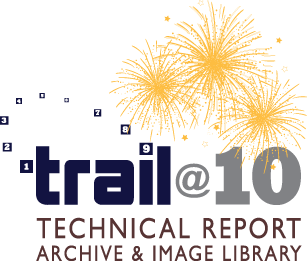TRAIL, the Technical Report Archive and Image Library, is a project started by librarians 10 years ago to digitize technical reports produced by various agencies in the United States government and to make them available to all users.
Current and past partners include: The University of Arizona, GWLA (Greater Western Library Alliance), CRL (Center for Research Libraries), Linda Hall Library, University of Hawaii, University of Michigan, Haithi Trust Digital Library, University of Washington, and the University of North Texas.
Technical reports that have been digitized can be found via the TRAIL Search Interface or through the research guides, which explain which series are available.
The technical reports provide another window to the history of science and engineering. Reports can be used to: examine how a concept can change over time, survey of species at a specific place and time, understand available technology, and other scientific and engineering concepts.
Librarians interested in continuing this mission can join at the institutional level or as an individual member. More information is listed here: https://www.crl.edu/grn/trail/about-trail/how-join-trail
If a library is downsizing a collection, staff may examine the Needs list as several reports have not been located: https://www.crl.edu/grn/trail/current-activities/needs-list
Technical reports can be used in the history of engineering, science, and medicine, research and also provide a perspective for social sciences and economic studies research.
An excellent example of a multidisciplinary report is A Preliminary Report Uranium, Radium, and Vanadium (written in 1916 by R.B. Moore and K.L. Kithil), which includes information about these elements and other interesting observations.
- Prices for the elements and which cities in Germany bought it.
- Cost analysis of mining.
- Locations in Colorado and Utah that have deposits of these elements with detailed descriptions on how to reach these areas.
- Descriptions of other mines in California, Nevada, North Carolina, New Mexico, Oklahoma, Australia, Austria, Germany, and Portugal.
- Photographs and maps of mines.
- Photograph and descriptions of mining equipment.
- Testing methods and equipment used.
- Uses of the elements, including a recommendation by the Imperial Department of Public Works in Austria to apply “direct exposure to radium rays is especially recommended for rheumatism, neuralgia, stiffness of the bones and joints, as well as chronic eczema”.
- Laboratories and scientists involved with research of these elements, including Madam Curie.
Technical reports can also be used to trace areas of responsibilities with the federal government. The agency that sponsored this report was the US Department of the Interior, Bureau of Mines. This agency was dissolved by Congress in 1995, but its functions were transferred to other agencies, such as the CDC (Centers for Disease Control) for mining statistics, USGS (US Geological Survey) for maps of mines, and EPA (Environmental Protection Agency) for environmental effects of mining.
Isabel Altamirano, Mechanical Engineering and Material Sciences Librarian, Georgia Institute of Technology, Atlanta, Georgia.
We welcome your comments and suggestions. If you have a resource that you would like to see highlighted please leave us a comment.
References:
http://www.crl.edu/grn/trail/about-trail/history-trail
https://journals.ala.org/dttp/article/view/6070/7795
http://digital.library.unt.edu/ark:/67531/metadc12283/m2/1/high_res_d/Bulletin0070.pdf



2 thoughts on “TRAIL – The Road To Search for Technical Documents”